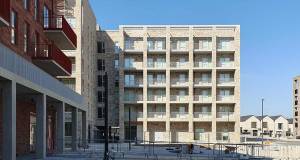
- Blogs
- Posted
The Jodrell Bank grand challenge
During a speech last year Theresa May challenged the construction industry to halve the energy use of new buildings, and to halve the cost of retrofit. But we already know how to meet these challenges, writes Peter Rickaby, and much more difficult tasks lie ahead.
At a conference in the wake of the 1982 OPEC oil embargo, the American engineer Fred Dubin posed a question: “How would your buildings fare if they had to run on half the energy you designed them to use?”.
This question was not a response to climate change, which was not yet on the agenda (although it lurked in the wings).
It was a challenge about the robustness of buildings against an uncertain political future. It provoked bewilderment, and much panicky talk of office buildings being rendered uninhabitable by lack of air conditioning, and even of freezing in the dark.
Thirty-five years later, energy performance standards have improved, and most new buildings probably do use half the energy they would have used in the early 1980s. For existing buildings, the picture is less clear – some refurbishments have halved energy use, but many have not.
But we are no longer bewildered: we know how to halve energy use, even if we don’t always rise to the challenge. The trick is to avoid designing energy demand into the form and fabric of buildings, and then needing to use fuel to engineer it out. Instead, use the form and fabric of the building to reduce energy demand, then satisfy the residual demand efficiently – which is of course a principle of the passive house standard.
Recently in the UK, a similar challenge has been presented. The Jodrell Bank grand challenge (named for a speech Theresa May delivered at the famous radio telescope in May 2018) has been embedded in the government’s ‘Clean Growth Strategy’. The challenge is to use new technologies and modern construction practices to at least halve the energy use of new buildings by 2030 — and to halve the cost of reaching the same standard in existing buildings too. Note that for existing buildings the challenge is only to halve the cost of halving energy use, not to achieve the reduction.
How might we meet this challenge? It seems to me that for the new build sector, for both domestic and non-domestic buildings, the challenge is technically trivial. If we take the energy performance standards in the current building regulations (in the UK or Ireland) as the baseline, then adopting the passive house standard, combined with some renewables, would easily get us there.
We have many domestic buildings, and some big non-domestic ones, that demonstrate this. We could be more ambitious and adopt the European NZEB standard.
The difficult part will be persuading the building industry to accept new standards.
However, the difficult part will be persuading the building industry to accept new standards, and to deliver them consistently. This requires a change of attitude in the construction industry (which in the UK always pushes back against proposed standards) and extensive training of designers and builders, to provide the necessary skills.
Here again, the passive house standard is part of the solution: the ‘performance gap’ between designed and actual energy use is really an attention to detail deficit, and one of the strengths of the passive house standard and its design software, PHPP, is that they tell us which details need our attention, both in design and on site.
Perhaps Ireland, with higher energy standards and longer experience of passive house, will do better than the UK in this respect. On a visit to new housing developments around Dublin last year, I was impressed not only by the designs but also by the quality of the work on site, and the pride taken in it by construction teams.
This article was originally published in issue 29 of Passive House Plus magazine. Want immediate access to all back issues and exclusive extra content? Click here to subscribe for as little as €10, or click here to receive the next issue free of charge
For existing buildings, the Jodrell Bank grand challenge is more demanding, and more important. Over 80% of the buildings that exist today will be in use in 2050, so if we are to meet our emissions targets in either country, big retrofit programmes are needed and reducing cost will be essential.
Nearly ten years ago, the UK’s Retrofit for the Future programme suggested that the average cost of one-off deep retrofit (80% emissions reduction) in social housing was between £80,000 and £90,000 (the Jodrell Bank grand challenge baseline), and that economies of scale might reduce it to £50,000. We also learned that the relationship between retrofit cost and emissions reduction is such that lowering the on-site emissions reduction target from 80% to 50% halves the retrofit cost.
Subsequent analyses of many housing stocks have confirmed that for 50% emissions reduction the average scale retrofit cost is less than £25,000, but the range is large: from less than £10,000 to more than £50,000. There are also many traditional and historic buildings where reducing emissions by 50% is not possible, so we will have to do better elsewhere, to compensate.
The Greater London Authority’s retrofit programmes are teaching us how to identify the low-hanging fruit: the homes that can be improved at least cost. SEAI’s deep retrofit programme in Ireland is teaching us technical and financial lessons about how to get houses to EPC/BER band A2.
What can we conclude about the Jodrell Bank grand challenge? It’s not much of a challenge: we already know how to achieve the required standard, and we are well on the way to achieving the cost target for existing dwellings. So, as they say in Ireland: “it’s not that grand!” The difficult parts will be introducing better standards to building regulations, changing attitudes, improving skills and implementing retrofit at scale.






